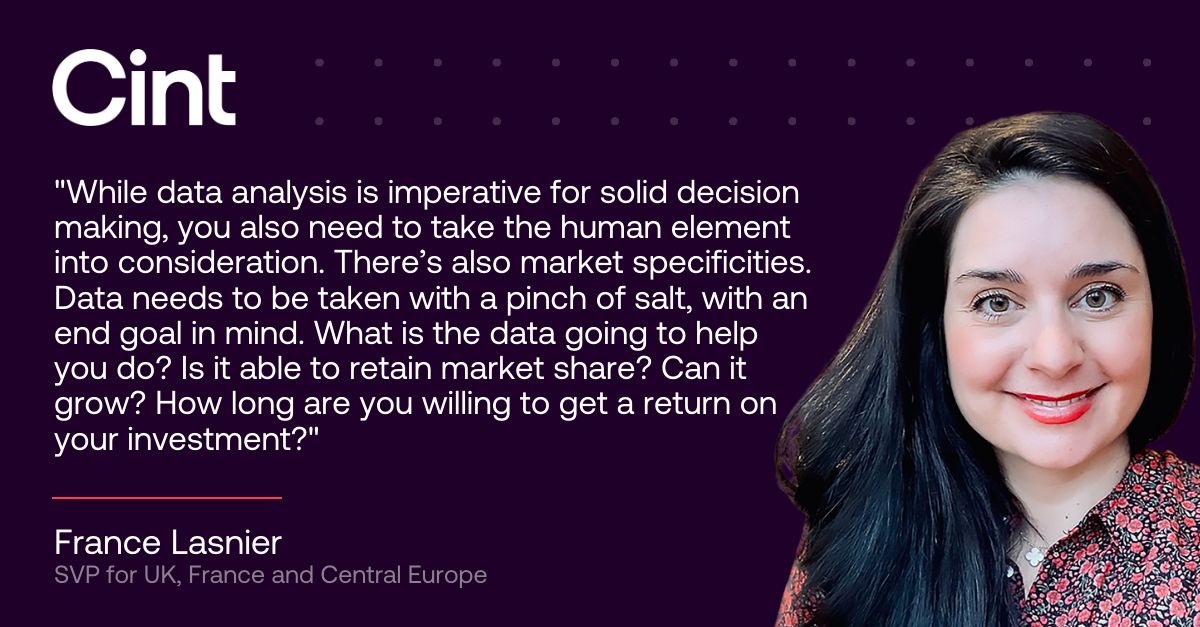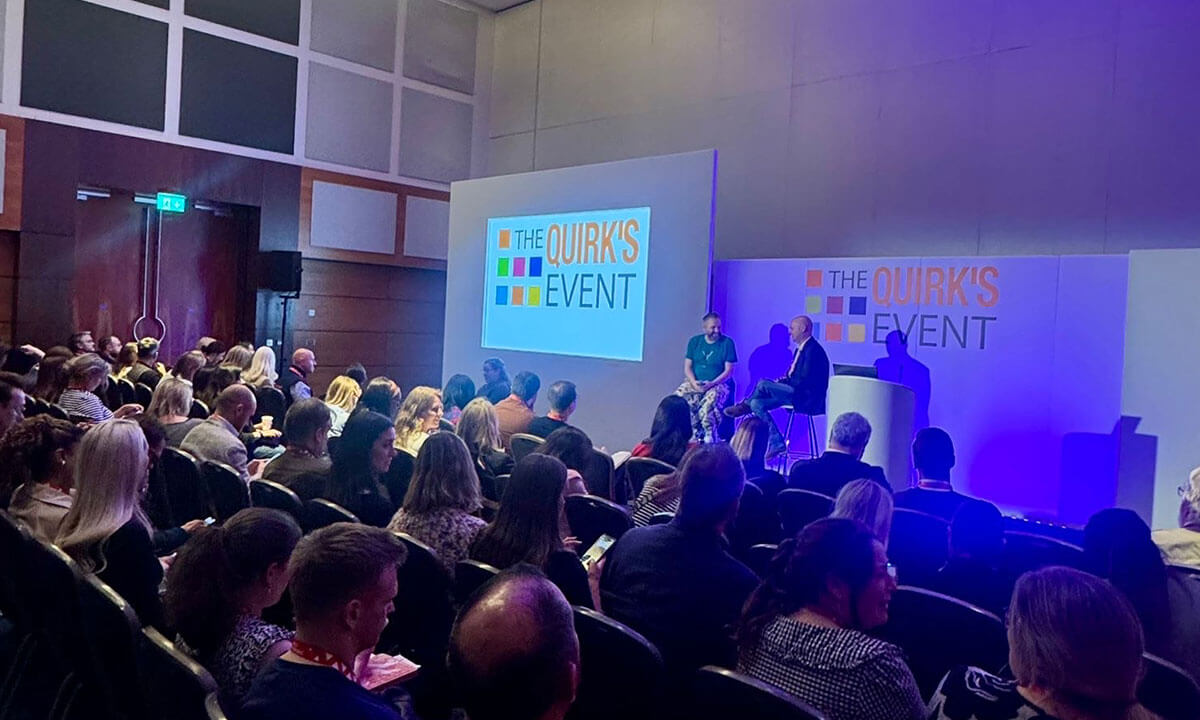What is data-driven decision making?
Before looking more deeply into what we do with data at Cint, it is important to explain what exactly it is that people mean when they bring up data-driven decision making. Making business decisions can be hard: it’s all too easy to get bogged down in the details. Even the simplest idea can become difficult to execute when you’re managing multiple moving parts and keeping stakeholders happy. Analyzing verifiable data to support key decisions is a way of simplifying things — conclusions can be drawn from drilling down into figures. Cint’s commercial team uses tools to track profitability, customer behavior, and survey completion rates, and analyzing that data allows us to make decisions about strategy, product, and how best to leverage insights for our customers. France Lasnier, SVP for UK, France and Central Europe, Cint, is someone who knows a thing or two about using data to drive commercial decisions. “The way we work with customers is to ensure that we are equipped with the right tools to enable us to know simple things like profitability, what are we selling to whom, what’s the margin we’re making on this, should we suggest a different solution to the customer?” Lasnier says. “Are we selling the right thing to the right customer?” This also applies to how we service customers, staying agile as a business allows us to make better decisions for ourselves and our clients. “We want to understand what the customer is doing, how they are tracking against budget, what their level of completed surveys is,” Lasnier says. “What are the things we need to advise the customer on the best way to get the best respondents at the best rates?” Lasnier points out that when it comes to assessing the importance of both quantitative and qualitative insights, it doesn’t have to be an either/or situation. “I’m always pushing my salespeople to do due diligence, for managers to look at our top customers and give them a call and ask them what their relationship with Cint is like, are we delivering what we’re supposed to deliver? It’s about getting qualitative statements on ways of working.”How is the data derived?
Having access to large and accurate datasets is paramount when it comes to making successful data-driven business decisions. How, though, do we go about getting their hands on that data? At Cint, there are a couple of invaluable tools used to do the job. “Those tools,” says Lasnier, “help us make the best decisions internally, or support customers on their journey to buying Cint solutions. When we’re asked about big decisions, we’re always asking ‘What is the data behind it?’” One of those tools is Salesforce, a state of the art CRM product. Lasnier adds that, “We also use Power BI, which is again a very useful tool to review numbers, but also to see performance and operational metrics, which is another way for us to advise our customers on what’s going well, what’s not going so well in one project, and to come back with recommendations to provide to our customers.” Lasnier gives an example of how we’re able to use the tools at our disposal to amplify data for customers, adding value and shedding light on decision making. “For example, if you are a panelist that watches a TV programme on our customers platform, a streaming platform, but have also answered a question about dog food, then it gives them a more holistic view of you. You buy this dog food and watch that show. So this is what we can license and send to our customers who want to have a more holistic understanding of their customers.” Another Cint employee well-versed in the ins and outs of data is Louis Nix, Senior Analyst, Product Operations. “How we go about collecting data is context-specific,” he says. “What is the actual use case for our clients that we’re driving?” And there is a lot of data in play at Cint. “With the client data sets, we’re talking tens of thousands of data points,” says Nix. “With respondents, we’re talking millions of data points a day.” Cint is also able to license data that is scalable, consented, and continuously verified, meaning customers can expand, build, or validate their audiences for surveys and marketing campaigns. If that wasn’t enough, we collaborate with a diverse set of behavioral data partners to enrich survey data, allowing our customers to gain deeper insights, build or analyze audiences, and inform their own data-driven solutions and strategies.Why is it Increasingly Important?
As industry-leading market researchers we pride ourselves on providing solutions that enable brands, agencies and other businesses to gain more efficient and impactful insights — and that’s why we’ve made data analysis central to how we operate as a business. We’re data-driven to ensure that you can be too. Having the tools in place to get hold of the data is one thing, knowing what to actually do with it is another. In Lasnier’s opinion the biggest question to ask when it comes to using data to drive decision making is a simple one: Why are you actually using it? She gives the example of using data in a sales presentation to elucidate this. “You want to have a concrete example for why a customer should buy your product or solution, always linked to an ROI. Why do we want to push this specific statistic in the sales collateral? It is because we want to add credibility. We want to showcase that.” Lasnier adds that this applies to thinking about how best to consider the implications of making your own organization more data-driven. “Again, why are you trying to do that?” Lasnier asks. This approach is echoed by Nix. “You have to ask yourself if the question that you’re trying to answer is worth the resources of the folks you’re putting into it.” He likens the data-driven approach to a closed loop system. “We have a great design team and they spend a lot of time talking to the users of our product, so they’ve got very clear qualitative feedback on what the sticking points are,” Nix says. “But they might also have assumptions they’ve developed from listening to users. We’re here to validate or invalidate those assumptions.” The loop (problem, assumption, validation, solution) can be closed by using data to determine metrics of success. Whether you’re looking to use data to save on costs or recruit more staff to fill key roles, always ensure there’s a clear goal in mind before allowing yourself to be swayed by the figures.What Works…and What Doesn’t?
It’d be irresponsible to make the claim that shifting a company’s strategic model to an entirely data-driven one is a solution that suits every organization under the sun. Lasnier points out that while data analysis is imperative for solid decision making, it shouldn’t be the only tool organizations rely on. “You need to take the human element into consideration,” Lasnier says. “There’s also market specificities. Data needs to be taken with a pinch of salt, with an end goal in mind. What is the data going to help you do? Is it able to retain market share? Can it grow? How long are you willing to get a return on your investment?”
“You need to take the human element into consideration,” Lasnier says. “There’s also market specificities. Data needs to be taken with a pinch of salt, with an end goal in mind. What is the data going to help you do? Is it able to retain market share? Can it grow? How long are you willing to get a return on your investment?”


































































































